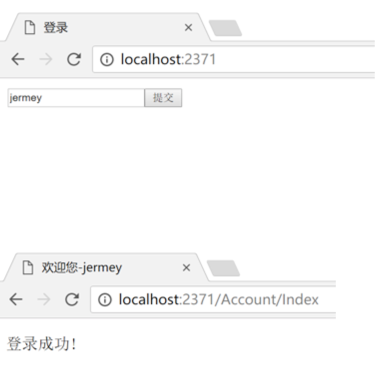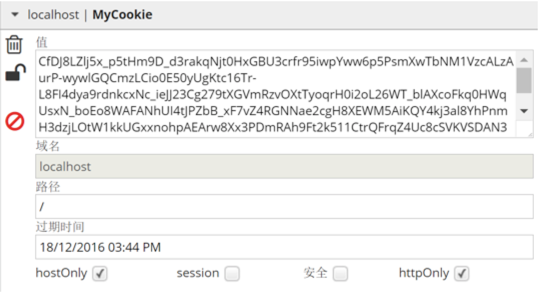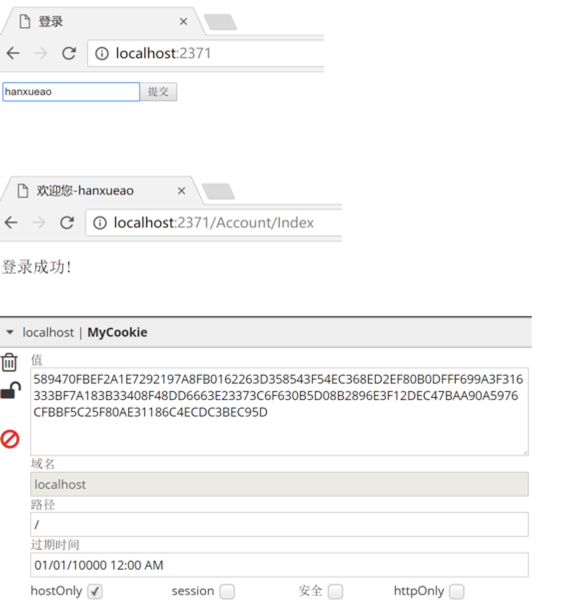.NET Core 已经热了好一阵子,1.1版本发布后其可用性也越来越高,开源、组件化、跨平台、性能优秀、社区活跃等等标签再加上“微软爸爸”主推和大力支持,尽管现阶段对比.net framework还是比较“稚嫩”,但可以想象到它光明的前景。作为.net 开发者你是否已经开始尝试将项目迁移到.net core上?这其中要解决的一个较大的问题就是如何让你的.net core和老.net framework站点实现身份验证兼容!
1、第一篇章我们先来看看.net core中对identity的实现,在Startup.cs的Configure中配置Cookie认证的相关属性
public void Configure(IApplicationBuilder app, IHostingEnvironment env){app.UseCookieAuthentication(new CookieAuthenticationOptions{AuthenticationScheme = "test",CookieName = "MyCookie"});}Controller
public IActionResult Index(){return View();}public IActionResult Login(){return View();}[HttpPost]public async Task<IActionResult> Login(string name){var identity = new ClaimsIdentity(new List<Claim>{new Claim(ClaimTypes.Name,name, ClaimValueTypes.String)},ClaimTypes.Authentication,ClaimTypes.Name,ClaimTypes.Role);var principal = new ClaimsPrincipal(identity);var properties = new AuthenticationProperties { IsPersistent = true };await HttpContext.Authentication.SignInAsync("test", principal, properties);return RedirectToAction("Index");}login 视图
<!DOCTYPE html><html><head><title>登录</title></head><body><form asp-controller="Account" asp-action="Login" method="post"><input type="text" name="name" /><input type="submit" value="提交" /></form></body></html>
index 视图
<!DOCTYPE html><html><head> <title>欢迎您-@User.Identity.Name</title></head><body>@if (User.Identity.IsAuthenticated){<p>登录成功!</p>}</body></html>下面是实现效果的截图:


ok,到此我们用.net core比较简单地实现了用户身份验证信息的保存和读取。
接着思考,如果我的.net framework项目想读取.net core项目保存的身份验证信息应该怎么做?
要让两个项目都接受同一个Identity至少需要三个条件:
- CookieName必须相同。
- Cookie的作用域名必须相同。
- 两个项目的Cookie认证必须使用同一个Ticket。
首先我们对.net core的Cookie认证添加domain属性和ticket属性
public void Configure(IApplicationBuilder app, IHostingEnvironment env){var protectionProvider = DataProtectionProvider.Create(new DirectoryInfo(@"C:keyPath"));var dataProtector = protectionProvider.CreateProtector("MyCookieAuthentication");var ticketFormat = new TicketDataFormat(dataProtector);app.UseCookieAuthentication(new CookieAuthenticationOptions{AuthenticationScheme = "test",CookieName = "MyCookie",CookieDomain = "localhost",TicketDataFormat = ticketFormat});}此时我们在.net core 项目中执行用户登录,程序会在我们指定的目录下生成key.xml

我们打开文件看看程序帮我们记录了那些信息
<?xml version="1.0" encoding="utf-8"?><key id="eb8b1b59-dbc5-4a28-97ad-2117a2e8f106" version="1"> <creationDate>2016-12-04T08:27:27.8435415Z</creationDate> <activationDate>2016-12-04T08:27:27.8214603Z</activationDate> <expirationDate>2017-03-04T08:27:27.8214603Z</expirationDate> <descriptor deserializerType="Microsoft.AspNetCore.DataProtection.AuthenticatedEncryption.ConfigurationModel.AuthenticatedEncryptorDescriptorDeserializer, Microsoft.AspNetCore.DataProtection, Version=1.1.0.0, Culture=neutral, PublicKeyToken=adb9793829ddae60"><descriptor> <encryption algorithm="AES_256_CBC" /> <validation algorithm="HMACSHA256" /> <masterKey p4:requiresEncryption="true" xmlns:p4="http://schemas.asp.net/2015/03/dataProtection"><value>yHdMEYlEBzcwpx0bRZVIbcGJ45/GqRwFjMfq8PJ+k7ZWsNMic0EMBgP33FOq9MFKX0XE/a1plhDizbb92ErQYw==</value> </masterKey></descriptor> </descriptor></key>
ok,接下来我们开始配置.net framework项目,同样,在Startup.cs中配置Cookie认证的相关属性。
public partial class Startup{public void Configuration(IAppBuilder app){var protectionProvider = DataProtectionProvider.Create(new DirectoryInfo(@"C:keyPath"));var dataProtector = protectionProvider.CreateProtector("MyCookieAuthentication");var ticketFormat = new AspNetTicketDataFormat(new DataProtectorShim(dataProtector));app.UseCookieAuthentication(new CookieAuthenticationOptions{AuthenticationType = "test",CookieName = "MyCookie",CookieDomain = "localhost",TicketDataFormat = ticketFormat});}}view
<!DOCTYPE html><html><head><title>.net framewor欢迎您-@User.Identity.Name</title></head><body>@if (User.Identity.IsAuthenticated){<p>.net framework登录成功!</p>}</body></html>写法和.net core 基本上是一致的,我们来看下能否成功获取用户名:

反之在.net framework中登录在.net core中获取身份验证信息的方法是一样的,这里就不重复写了。
然而,到此为止事情就圆满解决了吗?很遗憾,麻烦才刚刚开始!
--------------------------------------------------------------------------------
2、第二篇章如果你的子项目不多,也不复杂的情况下,新增一个.net core 站点,然后适当修改以前的.net framework站点,上述实例确实能够满足需求。可是如果你的子站点足够多,或者项目太过复杂,牵扯到的业务过于庞大或重要,这种情况下我们通常是不愿意动老项目的。或者说我们没有办法将所有的项目都进行更改,然后和新增的.net core站点同时上线,如果这么做了,那么更新周期会拉的很长不说,测试和更新之后的维护阶段压力都会很大。所以我们必须要寻找到一种方案,让.net core的身份验证机制完全迎合.net framwork。
因为.net framework 的cookie是对称加密,而.net core是非对称加密,所以要在.net core中动手的话必须要对.net core 默认的加密和解密操作进行拦截,如果可行的话最好的方案应该是将.net framework的FormsAuthentication类移植到.net core中。但是用reflector看了下,牵扯到的代码太多,剪不断理还乱,github上也没找到其源码,瞎忙活了一阵之后终于感慨:臣妾做不到(>﹏< )。
Cookie认证的相关属性
app.UseCookieAuthentication(new CookieAuthenticationOptions{AuthenticationScheme = "test",CookieName = "MyCookie",CookieDomain = "localhost",TicketDataFormat = new FormsAuthTicketDataFormat("")});FormsAuthTicketDataFormat
public class FormsAuthTicketDataFormat : ISecureDataFormat<AuthenticationTicket>{private string _authenticationScheme;public FormsAuthTicketDataFormat(string authenticationScheme){_authenticationScheme = authenticationScheme;}public AuthenticationTicket Unprotect(string protectedText, string purpose){var formsAuthTicket = GetFormsAuthTicket(protectedText);var name = formsAuthTicket.Name;DateTime issueDate = formsAuthTicket.IssueDate;DateTime expiration = formsAuthTicket.Expiration;var claimsIdentity = new ClaimsIdentity(new Claim[] { new Claim(ClaimTypes.Name, name) }, "Basic");var claimsPrincipal = new ClaimsPrincipal(claimsIdentity);var authProperties = new Microsoft.AspNetCore.Http.Authentication.AuthenticationProperties{IssuedUtc = issueDate,ExpiresUtc = expiration};var ticket = new AuthenticationTicket(claimsPrincipal, authProperties, _authenticationScheme);return ticket;}FormsAuthTicket GetFormsAuthTicket(string cookie){return DecryptCookie(cookie).Result;}async Task<FormsAuthTicket> DecryptCookie(string cookie){HttpClient _httpClient = new HttpClient();var response = await _httpClient.GetAsync("http://192.168.190.134/user/getMyTicket?cookie={cookie}");response.EnsureSuccessStatusCode();return await response.Content.ReadAsAsync<FormsAuthTicket>();}}FormsAuthTicket
public class FormsAuthTicket{public DateTime Expiration { get; set; }public DateTime IssueDate { get; set; }public string Name { get; set; }}以上实现了对cookie的解密拦截,然后通过webapi从.net framework获取ticket
[Route("getMyTicket")]public IHttpActionResult GetMyTicket(string cookie){var formsAuthTicket = FormsAuthentication.Decrypt(cookie);return Ok(new { formsAuthTicket.Name, formsAuthTicket.IssueDate, formsAuthTicket.Expiration });}有了webapi这条线,解密解决了,加密就更简单了,通过webapi获取加密后的cookie,.net core要做的只有一步,保存cookie就行了
[HttpPost]public async Task<IActionResult> Login(string name){HttpClient _httpClient = new HttpClient();var response = await _httpClient.GetAsync($"http://192.168.190.134/user/getMyCookie?name={name}");response.EnsureSuccessStatusCode();string cookieValue = (await response.Content.ReadAsStringAsync()).Trim(""");CookieOptions options = new CookieOptions();options.Expires = DateTime.MaxValue;HttpContext.Response.Cookies.Append("MyCookie", cookieValue, options);return RedirectToAction("Index");}webapi获取cookie
[Route("getMyCookie")]public string GetMyCookie(string name){FormsAuthentication.SetAuthCookie(name, false);return FormsAuthentication.GetAuthCookie(name, false).Value;}其余代码不用做任何更改,ok,我们来测试一下

ok,登录成功,至此完成.net framework和.net core身份验证的兼容,哎,如果.net core 的团队能多考虑一些这方面的兼容问题,哪怕是一个折中方案也能让开发者更有动力去做迁移。
以上就是本文的全部内容,希望对大家的学习有所帮助,也希望大家多多支持脚本之家。




